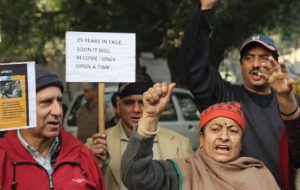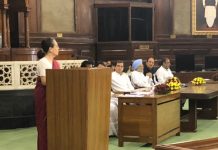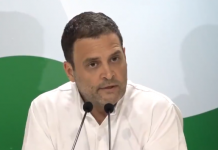 When Home Minister Amit Shah asserted that the Narendra Modi government will not stop until and unless all refugees in the country are granted citizenship under the Citizenship Amendment Act (CAA), the opposition parties were not amused. He went on to clarify that not a single person will lose citizenship as a result of CAA. While launching ‘Aar Noi Annay’ (no more injustice) campaign in West Bengal at a rally, he also said, “The opposition is terrorising minorities… I assure every person from the minority community that CAA only provides citizenship, does not take it away. It won’t affect your citizenship.”
When Home Minister Amit Shah asserted that the Narendra Modi government will not stop until and unless all refugees in the country are granted citizenship under the Citizenship Amendment Act (CAA), the opposition parties were not amused. He went on to clarify that not a single person will lose citizenship as a result of CAA. While launching ‘Aar Noi Annay’ (no more injustice) campaign in West Bengal at a rally, he also said, “The opposition is terrorising minorities… I assure every person from the minority community that CAA only provides citizenship, does not take it away. It won’t affect your citizenship.”
This raises a pertinent question: who is a minority person? In February, the Supreme Court of India directed the National Commission for Minorities (NCM) to respond within three months to a representation seeking the redefinition of the term “minority.” The representation had been pending before the Commission for 15 months.
One can’t understand why the Commission has been sitting on the representation for so long. Section 2(c) of the National Commission for Minorities Act, 1992, under which the NCM was constituted, defines “minority”, for the purposes of the Act, as a community notified as such by the Central Government.
The Central Government by way of two notifications, one in 1993 and the other in 2014, has notified six religious communities, namely, Muslims, Christians, Sikhs, Buddhists, Parsis and Jains as minorities in India. The NCM has no say really in deciding who is a minority and who isn’t.
Minorities not defined in Constitution
The Constitution of India, which came into effect nearly 70 years ago, grants special fundamental rights for the protection and advancement of minorities in India. However, the term “minority” itself is not defined in the Constitution. One can nevertheless infer from Articles 29 and 30 read together that the term primarily refers to religious and linguistic minorities.
Way back in 1958, the Supreme Court inquired in the Kerala Education Bill reference if a minority community is one which is numerically less than 50 percent. The Court then went on to remark that even if that question is answered in the affirmative, another question lingers, “50 percent of what, the entire population of India or the population of a state forming a part of the Union?” That question was left unanswered.
In the DAV College case of 1971, it was held that “Religious or linguistic minorities are to be determined only in relation to the particular legislation which is sought to be impugned.” In other words, if a Central legislation like the National Commission for Minorities Act is challenged, “minority” in such a case would have to be calibrated with reference to the population of the whole of India, not any one state.
The 2002 judgment of the apex court in the TMA Pai case examined afresh the meaning of “minority” under Article 30 and came to a curious conclusion that since the reorganization of States in India had been on linguistic lines, religious and linguistic minorities have to be considered state wise. Senior Advocate Fali S. Nariman, one of India’s leading jurists, while delivering the 7th Annual lecture of the NCM in 2014, remarked that “the decision in TMA Pai was an unmitigated disaster for the minorities.”
One must keep in mind through all this that minority rights are much wider than merely the right to establish and administer minority educational institutions.
The Constitutional amendment bills of 2004 that would have redefined minorities were widely opposed and allowed to lapse because it would have resulted in many anomalies and distortions in minority rights.
The 2005 verdict in the Bal Patil case, treats religious minorities and linguistic minorities differently. It agreed with TMA Pai that linguistic minorities are to be identified on the basis of their population within a particular state of India since the states were originally reorganized on linguistic lines. On the other hand, the Court observed that calibrating religious minority status on the basis of their population at the state level would militate against the integrity and secular fabric of India.
In conclusion, the six religious minority communities at the national level are the ones that fall within the meaning of “minority.”
The Indian context
Minorities in the Indian context means minority religions — Muslims, Christians, Jains, Sikhs etc. SC, ST, OBC are not in minority. They are not minority castes, they predominantly belong to Hinduism and are Hindus.
The dictionary meaning is: ‘an ethnic, racial, religious or other group having a distinctive presence within a society; a group having little power or representation relative to other groups within a society.’ In practice, ‘minorities’ are ethnic, religious or linguistic groups living among a ‘majority’ group in considerable and justified fear of persecution.
A good test of a group’s minority status is how the world, including the national media and international opinion, perceives their oppression. If they are brutalised, and nobody cares, then they are clearly a minority. This is what has happened, for instance, in the Sudan’s Darfur region: blacks being terrorised by Arabs. This was also the case for a long time with South Africa’s blacks under apartheid: they were really a ‘minority’ even though they were numerically a majority. In Europe, America, the Muslim world, and Marxist lands, the ‘minorities’ know exactly who they are, and the ‘majority’ knows who they are. There is no confusion as to who is top dog.
Indian scenario
But that is absolutely not the case in India. There are two reasons for this: one is the traditional Hindu acceptance of pluralism without any superiority complexes. The second is the fact that no Hindu feels himself to be part of the ‘majority’. Startlingly, because each Hindu considers himself part of his caste, each and every Hindu is a ‘minority’ person. There is no monolithic pan-Hindu identity: each individual owes primary allegiance to his caste group. This is something Marxists continually accuse Hindus of, but they don’t accept that, consequently, Hindus are fragmented.
Try this experiment. Ask any Hindu if they belong to a dominant group. You will find that they all, without fail, feel that they belong to an aggrieved group, one that is discriminated against. Lower-caste people have the historic baggage of oppression that they/their ancestors suffered and the glass ceilings they run up against. Upper-caste people feel they have been bad-mouthed and treated shoddily, and they resent reservations and concomitant loss of opportunity.
Attack on Hindus
In fact, it is the exact opposite. It appears that it is the Muslims and Christians who deliberately attack Hindus. As far as I can tell, Hindu-Muslim communal riots generally appear to be started by Muslims. And even if not necessarily physically violent (although they are indeed violent in the Northeast), Christians attack Hindus, and their deeply held beliefs, all the time.
When Hindus need protection
Thus, in India, Hindus are the ‘minorities’ needing protection. Every Hindu, by definition almost, is a ‘minority’ person. Yet, unbelievably, the Nehruvian Stalinists have arranged it so that even in areas where Hindus are in fact a numerical minority, such as in Muslim-dominated Jammu & Kashmir, Christian-dominated Mizoram and Nagaland, or Marxist-dominated West Bengal and Malabar, Hindus do not get the privileges so-called ‘minority’ Christians and Muslims get in other parts of India. So in India, Hindus are attacked, murdered, whatever, and by the time they get organized and attempt to take revenge, the police are there to prevent any violence. Surprisingly, no human rights person cares about them nor does media highlight their agonies either, though its a blatantly exploitive situation qua the majority community, which can succinctly be termed as a case of reverse discrimination.
Who is a Minority in India? — A Chronology
26.01.1950 The Constitution of India came into effect, with special fundamental rights for minorities:
Article 29 — Protection of interests of minorities
(1) Any section of the citizens residing in the territory of India or any part thereof having a distinct language, script or culture of its own shall have the right to conserve the same.
(2) No citizen shall be denied admission into any educational institution maintained by the State or receiving aid out of State funds on grounds only of religion, race, caste, language or any of them.
Article 30– Right of minorities to establish and administer educational institutions
(1) All minorities, whether based on religion or language, shall have the right to establish and administer educational institutions of their choice.
(2) The State shall not, in granting aid to educational institutions, discriminate against any educational institution on the ground that it is under the management of a minority, whether based on religion or language.
22.05.1958: The Kerala Education Bill, 1957. Reference Under Article 143(1) of The Constitution of India, the Supreme Court considered the following question among others: “Do any provisions of the Kerala Education Bill offend Article 30(1) of the Constitution?” In the course of answering this, the Apex Court discussed, “What is a minority? That is a term which is not defined in the Constitution. It is easy to say that a minority community means a community which is numerically less than 50 percent, but then the question is not fully answered, for part of the question has yet to be answered, namely, 50 percent of what? Is it 50 percent of the entire population of India or 50 percent of the population of a State forming a part of the Union?”
The Supreme Court observed that the question of whether the bill offended Art 30(1) itself proceeds on the footing that there are minorities in Kerala who are entitled to the rights conferred by Art. 30 (1). The Court further said, “strictly speaking, for answering the question we need not enquire as to what a minority community means or how it is to be ascertained.”
05.05.1971 In D.A.V. College Etc vs State of Punjab & Ors it was held that “Religious or linguistic minorities are to be determined only in relation to the particular legislation which is sought to be impugned; if it is State Legislature these minorities have to be determined in relation to the population of the State.”
12.01.1978 The setting up of Minorities Commission was envisaged in the Ministry of Home Affairs Resolution which specifically mentioned that, “despite the safeguards provided in the Constitution and the laws in force, there persists among the Minorities a feeling of inequality and discrimination. In order to preserve secular traditions and to promote National Integration the Government of India attaches the highest importance to the enforcement of the safeguards provided for the Minorities and is of the firm view that effective institutional arrangements are urgently required for the enforcement and implementation of all the safeguards provided for the Minorities in the Constitution, in the Central and State Laws and in the government policies and administrative schemes enunciated from time to time.”
1984 The Minorities Commission was detached from the Ministry of Home Affairs and placed under the newly created Ministry of Welfare.
30.03.1988 Ministry of Welfare, Government of India, vide resolution No. IV 12011/2/88 CLM amended clause 2 & 3 of the original Home Ministry Resolution of January 1978 thereby removing the Minority Commission’s jurisdiction over linguistic minorities of the country.
17.05.1992 The National Commission for Minorities Act, 1992 was enacted. 2(c) of the Act defines “minority”, for the purposes of this Act, means a community notified as such by the Central Government. Thus, only the Central Government can notify a community as a “minority” under the Act.
18.12.1992 Declaration on the Rights of Persons Belonging to National or Ethnic, Religious and Linguistic Minorities adopted by the UN General Assembly vide resolution No. 47/135, begins with the article: “States shall protect the existence and the national or ethnic, cultural, religious and linguistic identity of minorities within their respective territories and shall encourage conditions for the promotion of that identity.”
17.05.1993 The first statutory National Commission for Minorities (NCM) was set up.
23.10.1993 Vide a Gazette notification issued by the Ministry of Welfare, Government of India, five religious communities viz; the Muslims, Christians, Sikhs, Buddhists and Zoroastrians (Parsis) were notified as minority communities.
31.10.2002 In T.M.A. Pai Foundation & Ors vs State of Karnataka & Ors the Supreme answered the question “What is the meaning and content of the expression minorities in Article 30 of the Constitution of India?” as follows:
“Linguistic and religious minorities are covered by the expression “minority” under Article 30 of the Constitution. Since reorganization of the States in India has been on linguistic lines, therefore, for the purpose of determining the minority, the unit will be the State and not the whole of India. Thus, religious and linguistic minorities, who have been put at par in Article 30, have to be considered state wise.”
11.11.2004 The National Commission for Minority Educational Institutions (NCMEI) Act came into force.
2(da) “educational rights to minorities” means the rights of minorities to establish and administer educational institutions of their choice;
2(f) “minority”, for the purpose of this Act, means a community notified as such by the Central Government;
2(g) “Minority Educational Institution” means a college or an educational institution established and administered by a minority or minorities.
23.12.2004 The Constitution (103rd Amendment) Bill, 2004 and the NCM (Repeal) Bill, 2004 were introduced in Lok Sabha. The Bills were referred to the Department-related Parliamentary Standing Committee on Social Justice and Empowerment which submitted its report on February 21, 2006. The Amendment Bill proposed to establish a new National Commission for Minorities, with a constitutional status.
This bill was reportedly allowed to lapse because if the government attempted to push through the Bill, it would have had to redefine minorities, a proposal that was being strongly opposed by Muslims, Christians, Sikhs and other minorities alike. Leaders of the minority communities and experts who opposed the move argued that a state-specific definition of minorities would result in distortions in minority rights. Christians in many North-eastern states and Sikhs in Punjab would have been declared majority groups and consequently deprived of constitutionally-sanctioned minority rights. It would have resulted in many other anomalies like Christian students becoming ineligible for admission in minority educational institutions in other states as they would not have a domicile minority status there. In view of all these problems, Minister A.R. Antulay reportedly had assured that there would be no change in the definition of religious minorities.
08.08.2005 In Bal Patil & Anr vs Union of India & Ors, the Jain community sought issuance of a mandamus/direction to the Central Government to notify ‘Jains’ as a ‘minority’ community under section 2(c) of the National Commission for Minorities Act, 1992. In that judgement, the Supreme Court observed thus:
“The eleven judge Bench in TMA Pai Foundation Case had held that claims of minorities on both linguistic and religious basis would be each State as a unit. The country has already been reorganized in the year 1956 under the States Reorganization Act on the basis of language. Differential treatment to linguistic minorities based on language within the state is understandable. But if the same concept for minorities on the basis of religion is encouraged, the whole country, which is already under class and social conflicts due to various divisive forces, will further face division on the basis of religious diversities. Such claims to minority status based on religion would increase in the fond hope of various sections of people getting special protections, privileges and treatment as part of constitutional guarantee. Encouragement to such fissiparous tendencies would be a serious jolt to the secular structure of constitutional democracy.”
The Supreme Court rejected the Jain community’s prayer to “Direct the Central government to notify Jains as a religious minority by way of issuing a notification to this effect under Sec 2(c) of the NCM Act.”
27.01.2014 Jains notified as minority community by the Central Government.
10.11.2017 Advocate Ashwini Kumar Upadhyay had filed WP(C) 1064/2017 to declare the Notification dated 23.10.1993, arbitrary unreasonable and ultra-vires the Constitution but withdrew it with liberty to approach the National Commission for Minorities (NCM) and accordingly, submitted a representation on 17.11.2017. The NCM reportedly did not respond to his representation for 15 months.
11.02.2019 The writ petition WP(C) 94/2019 filed by Advocate Ashwini Upadhyay before the Supreme Court was disposed of. The Supreme Court was of the view that “the NCM should consider the representation dated 17th November, 2017 filed by the petitioner and pass appropriate orders thereon within a period of three months. Once the said exercise is completed, the petitioner will be free to avail of such remedies as available to him in law.” The petitioner had reportedly filed the writ petition with the following prayers:
- a) direct and declare that Section 2(c) of the NCM Act 1992 is void and inoperative for being arbitrary, unreasonable and offending Articles 14, 15 and 21 of the Constitution of India;
- b) direct and declare that the Notification on Minority Community dated 23.10.1993 [1993 –SO No.816(E) F.No.1/11/93-MC(D)] is void and inoperative for being arbitrary unreasonable and offending Articles 14, 15, 21, 29 and 30 of the Constitution of India;
- c) direct the Government to define “Minorities” and lay down guidelines for their identification, to ensure that only those religious and linguistic groups, which are socially economically and politically non-dominant and numerically inferior, may enjoy rights and protections guaranteed under Articles 29-30, with the State being the unit of determination;
- d) in the alternative to prayer (c), direct and declare that only those religious and linguistic groups of Indian citizens, which are socially economically and politically non-dominant and numerically not more than 1% of total population of that respective State, may enjoy rights and protections guaranteed under Articles 29-30 of the Constitution.
*Pro Bono Consultant. Advocate Punjab & Haryana High Court. With forty years in-depth experience in legal profession, he sheds light on the hidden aspects of this system through his incisive musings. He can be reached at alertlawyer@gmail.com
letters@tehelka.com













